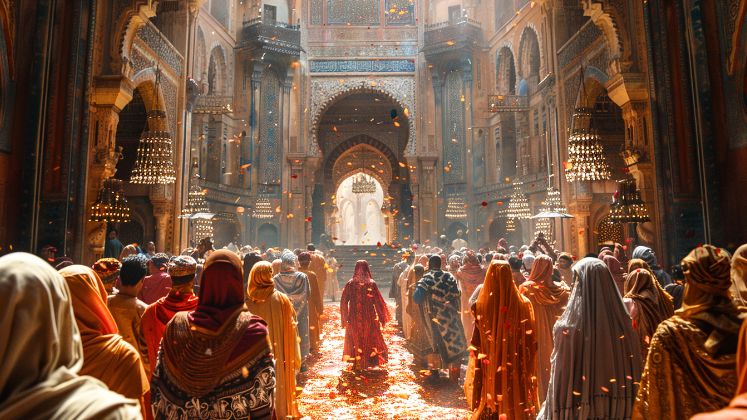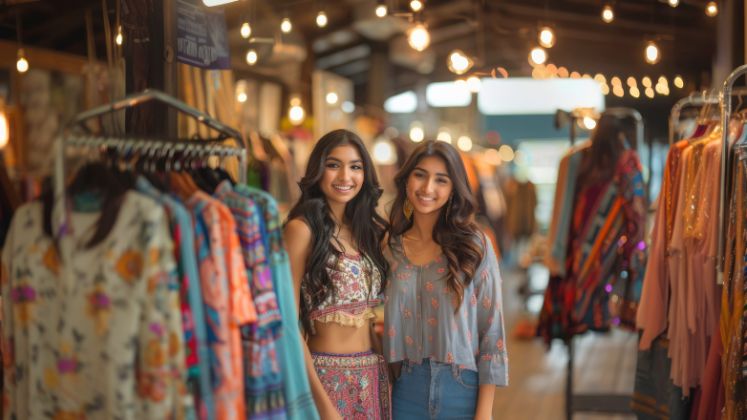India’s tourism sector is gearing up for a boom, as more travellers embark on religious trips across the country. Riding on this wave, Indian retailers are also expanding their presence in holy places.
In 2022, India’s religious tourism witnessed an impressive influx of 1,439 million tourists, generating a substantial revenue of Rs. 1.34 lakh crore, as reported by the Ministry of Tourism. Spiritual tourism is expected to be a cornerstone of India’s tourism industry growth, with 60 per cent of domestic tourism in the country centered around spiritual experiences. Furthermore, the country anticipates hosting over 30 million international travellers by 2028 for religious tourism purposes.
For instance, India could see an additional 50 million to 100 million tourists a year on account of the inauguration of Ram Mandir in Ayodhya — according to the global brokerage firm Jefferies. To provide context, this projected increase far surpasses the annual visitor numbers for renowned landmarks like Taj Mahal (6.5 million), Vatican City in Rome (9 million) and Mecca in Saudi Arabia (20 million).
With US $ 10 billion makeover underway, significant developments are reshaping Ayodhya. This includes the implementation of Phase-1 of a new airport capable of accommodating one million passengers as well as the expansion of the railway station to double its capacity from 30,000 to 60,000 passengers per day. Additionally, plans are underway for a 1,200-acre Greenfield township and improved road connectivity. Notably, three major roads – Ram Path (13km), Ram Janmabhoomi Path (2km) and Bhakti Path (750m) – have been reconstructed with imposing gates at entry and exit points. These comprehensive developments are anticipated to generate a multiplier effect in and around Ayodhya.
Jefferies also noted the deep spiritual, historical and cultural significance of other religious sites in India, such as the Tirupati Temple in Andhra Pradesh, which welcomes 25 million visitors annually and the Vaishno Devi Temple in Jammu and Kashmir, with 8 million visitors per year.
No wonder, major retail brands like Blackberrys, Cantabil, Manyavar, Spykar, Decathlon, Fabindia, Zudio, Reliance Trends and Raymond have already set up stores in cities like Amritsar, Ajmer, Varanasi, Katra, Somnath, Shirdi, Ayodhya, Puri, Tirupati, Mathura, Dwarka, Bodh Gaya, Guruvayur and Madurai.
Numerous factors have played a crucial role in enabling immersive experiences for travellers participating in this thriving travel trend, which spans across generations. These include the development of highways, expressways and ongoing road expansion initiatives, resulting in decreased travel time to spiritual destinations. Additionally, the upgrading of railway stations to accommodate the growing influx of passengers has made a huge impact. Moreover, the establishment of new airports and the enhancement of existing air routes in cities such as Varanasi, Amritsar, Tirupati and Shirdi have been undertaken to facilitate convenient travel for both domestic and international tourists alike.
The sacred real estate boom
The demand for land at sacred destinations is sparking a boom in ‘sacred real estate’, coveted by hospitality businesses and developers alike.
For example, Bollywood legend Amitabh Bachchan has snapped up land in a 7-star development by The House of Abhinandan Lodha (HoABL) near Shri Ram Janmabhoomi Temple in Ayodhya. This project, called The Sarayu, spans 51 acres and includes residential plots, villas and high-rise luxury apartments.
The Abhinandan Lodha group, along with top-notch hospitality partners, plans to invest over Rs. 2,000 crore to build five luxury hotels in heritage cities like Ayodhya, Varanasi, Vrindavan, Shimla and Amritsar.
Another real estate player, Anant Raj Ltd., plans to invest Rs. 1,000 crore in four projects across three cities, including Tirupati. With an investment of Rs. 7,200 crore, Japanese hotel chain Hotel Management International Company Limited (HMI) is developing luxury hotels in 30 major cities in Uttar Pradesh, including Ayodhya, Agra and Varanasi.
Since the groundbreaking ceremony for the Ram temple in August 2020, land prices and property deals in Ayodhya have soared by 50 per cent. The Uttar Pradesh government is planning a 1,000-acre township called ‘New Ayodhya,’ on the city’s outskirts blending contemporary and traditional architectural elements. This will be India’s first vastu-based township.
Varanasi experienced a similar property boom when the government built the Kashi Vishwanath corridor. This trend is now visible in other religious destinations like Vrindavan, Rishikesh, Amritsar and Shirdi, driven by the demand for hotels and retirement homes.
Budget hospitality chain Oyo is also jumping on to the bandwagon, planning to launch 400 new properties in major spiritual hotspots by the end of this year. This move is fuelled by a 350 per cent increase in searches for Ayodhya on the Oyo platform, driven by the opening of the Ram Mandir on 22nd January. Popular destinations like Puri, Shirdi, Varanasi, Amritsar, Tirupati, Haridwar, Katra-Vaishno Devi and Char Dham route are all on Oyo’s expansion list.
However, experts emphasise the pressing need for developing more townships with modern amenities to cater to tourists from major cities and abroad to help prolong their stay. “Without the right infrastructure—quality accommodations, diverse cuisine options, hygiene and accessible air, road, and rail connections to larger cities—people with higher spending power will be reluctant to visit,” pointed out Kunal Mehta, Head of Strategy, India Business (Retail, QSR, CPG), Tata Consultancy Services.
Brands doing phenomenal business
“We opened our inaugural store in Ayodhya this year and have been operating in Varanasi for over two years at JHV Mall, doing phenomenal business. When people see our signage in these tourism hotspots and then in their cities, it reinforces our brand presence. In the last two-three years, religious tourism has helped boost our sales,” said Yuvraj Arora, Partner, Octave Apparels, a lifestyle brand selling five million garments annually and boasting over 400 outlets nationwide, along with a significant global presence. With a realised turnover at over Rs. 600 crore annually, the brand plans to open two more stores in Varanasi soon.
“We already have a presence in major religiously significant cities like Varanasi, Mathura, Ayodhya, Haridwar, Amritsar and Puri. We’ve observed that these locations are evolving into cultural hubs where traditions and celebrations are deeply valued,” said Vedant Modi, CRO, Vedant Fashions Ltd., – Manyavar-Mohey, while stating of late, they have witnessed increased footfalls in these regions.
Headquartered in Kolkata, Vedant Fashions is primarily engaged in manufacturing, trading and sale of readymade Indian wedding and celebrationwear for men, women and kids under the brand names Manyavar, Mohey, Mebaz, Twamev and Manthan. By December FY ’24, the company had spread its retail footprint to 1.64 million sq. ft. across India with 657 EBOs in 250 cities and towns in India. Apart from India, it has 16 EBOs in countries including the USA, UAE, Canada and the UK.
Womenswear brand Madame, which already has a couple of stores in Varanasi, is now setting its sights on Ayodhya. “Footfall is a significant factor. However, the main advantage is increased visibility. Even if tourists don’t make immediate purchases, the exposure helps in building brand recognition, leading to sales in other locations where these tourists live,” said Akhil Jain, Director of Madame.
Madame boasts a network of over 150 exclusive stores across India and posted an annual turnover of Rs. 370 crore during FY 2022-23. The brand sells over 30 lakh units annually and sources 15 to 30 per cent of its products from India.
Sacred Cities Experience Growth In Retail
Mall Clusters (Rental values in INR / sq. ft. / month)
High Streets (Rental values in INR / sq. ft. / month)
Ayodhya
| Mall of Awadh | -150 |
| Civil Lines | -150-180 |
| Rampath | -100-130 |
| Brands | Pantaloons, Manyavar, Reliance, Trends, Raymond |
| Tourist Footfall | Ayodhya has turned into the most popular religious tourism destination of the world surpassing even Mecca and Vatican City. With the consecration of Ram Mandir, India could see an additional 50 million to 100 million tourists a year. |
Katra
| Jammu Road | -160 – 180 |
| Local Brands | |
| Tourist Footfall | Katra,known as the home to Mata Vaishno Devi Temple, has emerged as a prominent pilgrim hotspot, witnessing a substantial surge in tourism in recent times. In 2023, the temple attracted 9.5 million devotees. |
Dwarka
| Dwarka Market | -110 |
| Dwarka Outside Marke | -70 |
| Local brands | |
| Tourist Footfall | From January 2022 to July 2022, 6.81 crore of tourists visited Gujarat. Out of which, Dwarka has a footfall of around 36.08 lakhs as a religious destination. |
Varanasi
| IP Sigra Mall | -220 |
| IP Vijaya Mall | -200 |
| JHV Mall | -220 |
| PDR Mall | -150 |
| Sigra | -200 – 220 |
| Mehmoorganj | -170 – 200 |
| Durgakund Road, Bhelupur | -180 – 200 |
| Brands | Pantaloons, Shoppers Stop, Manyavar, Reliance Trends, Zudio, Spykar |
| Tourist Footfall | Varanasi (Kashi) attracted 82 million tourists last year. Varanasi has now exceeded Agra, home to the Taj Mahal, becoming the most visited destination in Uttar Pradesh. |
Bodh Gaya
| Swarajpuri Road | -120 |
| K B Road | -90 |
| Circuit House Road | -75 |
| Brands | Blackberrys, Fabindia, Manyavar, Raymond, Pantaloons, V-Mart |
| Tourist Footfall | According to reports, around 70,000 tourists visit Bodh Gaya every month. |
Madurai
| Vishal de Mall | -80 |
| Kalavasal Bypass | -120-130 |
| Anna Nagar/KK Nagar | -120-130 |
| Chinna Chokkikulam | -90-100 |
| Brands | BIBA, Levi’s, Max, Trends, Van Heusen, Westside |
| Tourist Footfall | In 2018, Madurai saw a significant milestone as the number of domestic tourists reached two crore within a year. This included 2.09 crore visitors exploring major attractions such as the Meenakshi Amman Temple and Thirumalai Naicker Mahal in the city. |
Mathura
| Pacific Mall | -120 |
| Krishna Nagar | -120-150 |
| Brands | Fabindia, United Colors of Benetton, Zudio |
| Tourist Footfall | In 2021, Mathura, believed to be the birthplace of Lord Krishna, welcomed over 5.43 million tourists. |
Tirupati
| AIR Bypass Road | -140-160 |
| Mahal Road | -100-120 |
| Karakambadi Road | -80-100 |
| Brands | Pantaloons, Levi’s, Max, Puma, Style Union |
| Tourist Footfall | As per reports, a projected 50,000 to 100,000 devotees visit the Tirupati Balaji temple at Tirumala daily, on an average. |
Amritsar
| Mall of Amritsar | -250-300 |
| VR Amritsar Mall | -150-200 |
| Celebration Mall | -60-80 |
| Golden Temple Road | -800-1,000 |
| Mall Road | -150-200 |
| Lawrence Road | -100-150 |
| Brands | Bata, Biba, Fabindia, Jockey, Manyavar, Octave, Skechers, Woodland |
| Tourist Football | Latest data shows that the daily arrival of tourists to Amritsar has exceeded the 70,000 to 80,000 mark, getting up to one lakh on weekends. This rush is clear from the doubling of air passengers, which increased to over 20 lakh in 2022 from around 10 lakh in 2015. |
Ajmer
| City Square | -140-170 |
| Mittal Mall | -150-170 |
| Vaishali Nagar | -165-200 |
| Panchsheel | -150-180 |
| Hathi Bhata Jaipur Road | -100-150 |
| Brands | Max, Blackberrys, Decathlon |
| Tourist footfall | Domestic tourist arrivals of about 100,000 a month, barring the summer months of May, June and July, provide a clear base load for the tourism industry in Ajmer |
Somnath
| Tower Chowk | -70-80 |
| Veraval-Junagadh Road | -70-80 |
| Brands | Spykar, Reliance Trends |
| Tourist footfall | Around 70 to 80 lakh devotees visit yearly. During Kartik Poornima, a huge fair takes place. Furthermore, Shivratri in February, the month of Shravan and the Diwali holidays see a substantial influx of devotees. |
Puri
| Swargadwar | -125 |
| Brands | Blackberrys, Manyavar, Raymond, Reliance Trends, Bata |
| Tourist Footfall | Puri attracts 20,000 to 30,000 visitors every day. Puri witnesses a major surge during important events like the Puri Rath Yatra, with yearly footfall ranging from 7 to 10 million visitors. The holy city draws almost half of Odisha’s total visitors. |
Shirdi
| Manmad Road | -100 |
| Brands | Fabindia, Nike, Reliance Trends, Decathlon |
| Tourist Footfall | In Shirdi, the Sai Baba temple witnesses around 40,000 to 50,000 visitors daily, totalling 15 to 20 million visitors yearly, drawing pilgrims not only from Maharashtra and neighbouring states but also from across the country and overseas. |
Guruvayur
| West Nada | -100 |
| South Nada | -90-100 |
| North Nada | -90-100 |
| East Nada | -90-100 |
| Chavakkad | -100 |
| Brands | Reliance Trends, Allen Solly, Jockey |
| Tourist Footfall | In 2022, Guruvayur, a town in Kerala, saw approximately 1.4 million domestic tourist arrivals. |
Rent Data Source: CBRE
“When we opened the store in Ayodhya, there was hardly any tourism. Recently we have renovated and upgraded the store for better customer experience,” said Gurinder Singh, Zonal Head, Monte Carlo. The brand operated 350 EBOs across India in FY ’23 and witnessed a 22 percent increase in business compared to FY ’22, resulting in a turnover of approximately Rs. 1,100 crore.
“In cities experiencing an increase in religious tourism, we prioritise establishing retail outlets near prominent pilgrimage sites and religious landmarks,” said Deepak Bansal, Director of Cantabil Retail India Ltd., which has stores in Ayodhya, Varanasi, Mathura, Prayagraj and Allahabad.
Currently, Cantabil operates over 500 exclusive retail outlets across India, offering formal, party, casual and ultra-casual clothing for both men and women. The brand opened its 500th store in Ayodhya at the start of 2024.
Some of the other major brands and retailers that have established themselves in Ayodhya are Reliance Trends, Raymond, Cantabil, Pantaloons, Sketchers and Woodland.
Focus on ethnicwear and maturewear
Discussing the difference in collections at religious versus traditional locations, Yuvraj commented, “When we focus on traditional regions, we prioritise more casualwear. For example, in Ayodhya or Varanasi, we focus on more maturewear, such as polos, quality shirts and other refined styles.”
He also pointed out that they consider the presence of their peers in such locations before opening stores. “We look at our peers like Spykar, Mufti, Benetton, Pepe and large format stores like Reliance Trends or Zudio. Wherever these players are located becomes a market hub for us. We reach out to property consultants who specialise in those regions and then conduct our due diligence on ground.”
“Our target audience includes both tourists and locals. Tourists seeking Indianwear for religious ceremonies become a natural extension for us,” said Vedant Modi. He added, “Moreover, tourists visiting religious hotspots often seek authentic experiences and ways to connect with the local culture and traditions. As a result, there’s a higher demand for Indian attire that reflects the cultural ethos of the region.”
Akhil also noted that ethnicwear tends to attract locals, while accessories are popular as well. Westernwear, on the other hand, has the advantage of attracting attention from the transient tourist population. He stated, “We focus more on regular customers who live in these regions and are more likely to become repeat buyers.”
According to Gurinder Singh, apart from locals, it’s the nearby B & C class towns from where customers come to make purchases.
Emerging brands are also betting big on religious tourism. According to Sarabjeet Saluja, Co-founder and CEO of Saundh, an affordable-luxury label specialising in womenswear, the brand generates good business from its Amritsar store. “A larger segment of our customer base in Amritsar are NRIs. We have seen one of the highest conversion rates for this store specifically—almost 80 per cent,” he said. As of 2023, Saundh has 31 stores across 18 cities. The brand, which has also launched a menswear vertical, plans on expanding further to at least 50 stores in the coming fiscal year.
“People often come with their outfits planned for visiting religious places, but they like to pick up something unique, like a locally seasoned souvenir. They are inclined towards ethnic items.”
Retailers face challenges
However, retailers and experts caution that opening stores in these locations isn’t all smooth sailing. There are significant challenges that retailers and brands need to be aware of.
“While things are improving in these emerging towns, the quality of real estate can still pose a challenge,” cautioned Akhil. Deepak too noted that brands planning to open stores in these areas must consider the nascent infrastructure and seasonal fluctuations in foot traffic, which require careful planning as many of these religious places are often classified as B or C towns.
Additionally, the younger generation is not well-represented in these areas. The absence of grand malls means fewer entertainment options for tourists, which can shorten their stays.
“The retailer will also need to carefully curate their clothing range keeping in mind the religious and cultural sensitivities,” stated Kunal Mehta. He also highlighted that finding staff to run operations could be difficult, with potential relocation issues for employees.
Furthermore, many tourists in these regions come from lower-income strata, which affects their spending power.
Despite these hurdles, the synergy between religious tourism and retail continues to foster opportunities for both industries, driving economic growth and offering enriched experiences for travellers while revitalising local economies.










